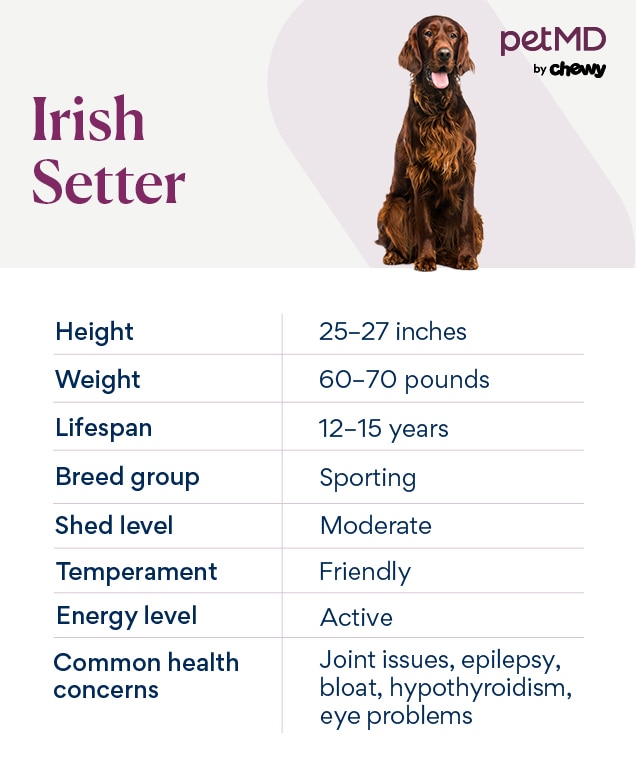Irish Setter
The Irish Setter’s glossy red coat might be what initially draws the eye, but it’s the breed’s famously sweet temper, playful nature, and athleticism that’s long made them popular family pets and hunting companions.
That said, they can be rambunctious and require a lot of exercise, even into adulthood. Considering their size (60-70 pounds with long legs), they’re not a good fit for apartment living. And potential pet parents need to be prepared to brush that striking coat just about every day to prevent it from matting.
Caring for an Irish Setter

It is important to understand that the Irish Setter is a field dog that thrives on exercise, says Bruce Foote, 1st vice president of the Irish Setter Club of America.
Regular grooming, including frequent brushing, is also crucial because their beautiful coats are prone to matting and collecting burrs. And, Foote adds, “They definitely like human interaction, so they need as much house time and human contact as possible. They are not a dog to be put in the backyard and ignored.”
Irish Setter Health Issues
Typically a healthy breed, the Irish Setter dog generally has a lifespan of around 14 years, says Dwight Alleyne, DVM, medical director at Destination Pet of Woodstock in Woodstock, Georgia. However, pet parents should be aware of a few health issues.
Bloat and GDV
Gastric dilatation and volvulus, a severe form of bloat in dogs, can be an issue with this breed. With GDV, the stomach fills with gas and then twists. One way to help prevent this life-threatening condition is called gastropexy, a surgery that tacks the stomach to the dog’s abdomen wall so it can’t twist. This procedure is commonly done during a spay or neuter surgery.
Irish Setter parents need to be aware of the signs of bloat and GDV, including:
-
Inability to settle
-
Lack of appetite
-
Drooling
-
Retching or vomiting
Orthopedic Conditions
Alleyne notes that orthopedic issues, such as hip dysplasia and cruciate ligament tears associated with the knees, are fairly common with Irish Setters.
Hip dysplasia, which is seen frequently in large-breed dogs like this, occurs when the hip joint develops abnormally and causes a loose joint. This can result in discomfort and limited mobility and, over time, the inflammation and scar tissue it causes can lead to arthritis. If you notice signs of discomfort or reduced mobility in your Irish Setter, talk to your veterinarian about options like nutrition supplements, anti-inflammatory medications, or even surgery if the case is severe.
Cruciate ligament tears can come from either wear and tear or, less commonly, a sudden traumatic rupture. Surgery is required to prevent additional lameness and arthritis in the knee and hind leg.
Hypothyroidism
This common endocrine disease is caused by decreased production of thyroid hormones. Symptoms of hypothyroidism in dogs include:
-
Weight gain
-
Lethargy
-
Heat-seeking behavior
-
Chronic skin and ear infections
-
Dry and brittle hair with a thinning coat
-
Increased skin pigmentation
-
Inability to regrow hair
Related problems that are more difficult to notice may include reproductive problems, nervous-system issues, and dry eye.
While there is no cure for hypothyroidism, it can be easily treated for the remainder of the dog’s life with an oral medication called levothyroxine. If left untreated, hypothyroidism is likely to shorten your dog’s lifespan.
Epilepsy
Certain breeds, such as Irish Setters, are predisposed to seizures with no underlying cause, leading to a diagnosis of primary epilepsy. For dogs experiencing regular seizures with no other underlying cause that can be treated, medications like phenobarbital, levetiracetam, and/or potassium bromide can help reduce seizure severity and frequency.
Progressive Retinal Atrophy (PRA)
This degenerative eye disorder eventually leads to blindness, but it can be detectable years before symptoms occur. There is DNA testing for PRA in dogs, and reputable breeders should have their dogs’ eyes certified annually.
Osteochondritis Dissecans (OCD)
Osteochondritis dissecans (OCD) is caused by excess growth in the cartilage of the joints. It’s most commonly seen in the elbows, but it can also occur in the shoulder; in either location, it causes pain and leads to decreased mobility. Corrective surgery is required for treatment.
What To Feed an Irish Setter
Feed your Irish Setter a balanced diet of a commercially available food approved by the Association of American Feed Control Officials (AAFCO). Proper nutrition will help keep her healthy and keep that gorgeous red coat in great shape.
How To Feed an Irish Setter
Foote recommends feeding your Irish Setter two smaller meals rather than a single large meal each day; this will help reduce the chances of bloat. Opt for a food appropriate for your Irish Setter’s life stage (so, choose a puppy food for Irish Setter puppies), and talk to your veterinarian if you have specific concerns about your dog’s food or how to feed them.
How Much Should You Feed an Irish Setter?
The label on your AAFCO-approved food should give a good idea of how much food your Irish Setter should get each meal based on her size and life stage. If you’re unsure, talk with your veterinarian. They can help determine how much you should feed your dog and evaluate her body composition.
Nutritional Tips for Irish Setters
Because they’re so active and tend to have a high metabolism, Irish Setters may require more food than you’d expect for their size. But you still need to be cautious not to overfeed them, because any dog can potentially become overweight. Because of the orthopedic issues this breed can experience, you might want to discuss joint health supplements with your vet.
Behavior and Training Tips for Irish Setters
Irish Setter Personality and Temperament
“Irish Setters love people and are relatively high-energy, so children are fine, but toddlers are at risk of being accidentally knocked down,” Foote says. Irish Setters are usually okay with other pets, including cats, as long as proper introductions are made.
Overall, Foote says, this is a fun-loving breed that’s game for just about anything their families want to do. “They love to go places and do things, so they fit well with an active lifestyle,” he says. By the time your Irish Setter is 3 or 4, she’ll probably settle down—but until then, be prepared to have some puppy-size energy in an adult-size dog.
Irish Setter Behavior
While they typically only bark when necessary, Irish Setters can be chewers or develop other destructive habits, especially if left to their own devices for too long. Remember, this breed wants to spend time with family and has quite a bit of energy to burn off—and if you’re not helping them find appropriate ways to be engaged, they may find their own outlets. Generally, though, they’re friendly, social, and happy to make new friends.
Irish Setter Training
Foote is quick to dispel one common misconception about the breed: “Irish Setters are not stupid,” he says. “They are intelligent and quick to learn new things.”
That said, they can also be independent. That independence, paired with their playful nature, means it’s especially important to keep training sessions fun, and reward your pup handsomely with praise and healthy dog treats. Be patient, consistent, and positive, and you’ll end up with the nicely mannered Irish Setter you’re aiming for.
Fun Activities for Irish Setters
-
Obedience
-
Rally
-
Agility
-
Dock diving
-
Lure coursing
-
Jogging
-
Playing fetch (or any game)
-
Hiking
-
Swimming
-
Hunting
-
Working as therapy dogs
-
Spending time with family
Irish Setter Grooming Guide
To keep the Irish Setter’s signature coat looking sleek and glossy, regular grooming is required in the form of daily (or at least 2-3 times a week) brushing to prevent mats, weekly ear cleaning, and a more robust grooming session to trim their toenails and fur each month.
Skin Care
This breed’s skin does not usually require special care. But if you notice dryness, redness, or other changes, that’s a cue to talk to your veterinarian.
Coat Care
“Maintaining their coats is important to keep them from developing mats,” Alleyne says. “It is important that they receive regular brushing and grooming on a consistent schedule.”
For pets (as opposed to show dogs), grooming can be done monthly by a professional. But, Foote says, if you have the right grooming tools and understand what to do, you can probably manage the upkeep yourself.
“The basic tools are good clippers, scissors, thinning shears, a hairbrush and comb, and a de-matting brush,” he says. If you bathe your Irish Setter at home, use a gentle shampoo designed for dogs.
Ear Care
Weekly ear checks and cleaning are recommended for Irish Setters. “They can be prone to allergies, especially associated with ears, which can lead to infections,” says Alleyne. If you notice redness or odor, or if your dog starts scratching her ears, shaking her head, or frequently tilting her head, discuss the potential of infection with your veterinarian.
Considerations for Pet Parents
“People new to the breed frequently underestimate how big that little puppy is going to become,” says Foote. Underestimating the amount of time, attention, and interaction they’ll require is also common.
He recommends new pet parents be prepared to fully dog-proof their home: “Move breakable objects up high, have lots of dog toys available so they don’t chew on furniture, and keep low tables clear.”
Regular, consistent grooming is a must, so it’s best to look at that as special bonding time with your new best friend.
Irish Setter FAQs
Is an Irish Setter a good family dog?
Absolutely. Irish Setters love to play with family members of all ages. They are sweet and affectionate, and are generally happy to be involved in whatever their people want to do. Just keep in mind that they can be exceptionally enthusiastic, so they’re best suited for active families who want to include them in the fun and games.
Is an Irish Setter a smart dog?
Yes! This is an intelligent breed that learns quickly. However, as a member of the sporting group, the pups were bred to be independent thinkers. So, when it comes to your positive reinforcement training, keep things short, interesting, and fun to keep her attention.
Do Irish Setters bark a lot?
No, Irish Setters are not generally big barkers. They alert when something is happening, but nuisance barking is unlikely to be a problem with this breed.
What’s the difference between Irish Setters vs. Irish Red and White Setters?
Setters, in general, got their name for the way they show a hunter they’ve found a bird, which is by “setting” down on their belly. There are multiple types of Setters, and all Setter breeds (including the Gordon Setter, the English Setter, the Irish Setter, and the Irish Red and White Setter) are officially separate breeds.
The differences between Irish Setters and Irish Red and White Setters, specifically, largely come down to appearance. Irish Red and White Setters are shorter and stockier than Irish Setters—and, as their name suggests, they wear a coat of white with red patches.
Featured Image: iStock/Aleksandr Zotov
